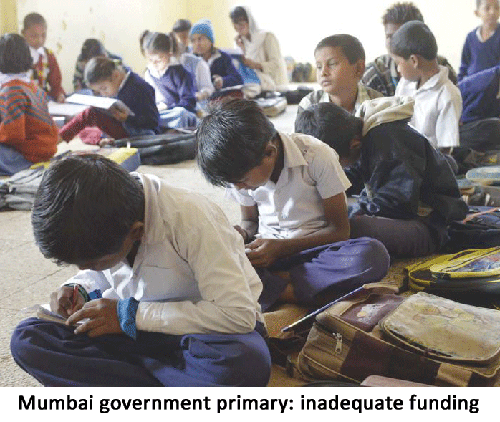 When the bjp-shiv sena was swept to power in Maharashtra (pop. 114 million) — India’s most industrialised state — in October 2014, one of the alliance’s major promises was larger budgets for education and education reform. But 27 months after the BJP-led state government was sworn in, the promise remains unfulfilled.
When the bjp-shiv sena was swept to power in Maharashtra (pop. 114 million) — India’s most industrialised state — in October 2014, one of the alliance’s major promises was larger budgets for education and education reform. But 27 months after the BJP-led state government was sworn in, the promise remains unfulfilled.
A recent study released in Mumbai (January 10) of the Delhi-based Centre for Budget and Governance Accountability (CBGA, estb.2005), an independent, non-profit policy research organisation, and the well-known NGO Child Relief and You (CRY, estb.1979), states that Maharashtra’s budget provision for primary and higher secondary (classes I-XII) education has been stagnant for three years (2012-13 to 2015-16).
The CRY-CBGA report titled Public Financing of School Education in India: A Fact Sheet details the budgetary provision for school education of ten economically progressive and backward states including Maharashtra, Bihar, Chhattisgarh, Jharkhand, Karnataka, Madhya Pradesh, Odisha, Rajasthan, Tamil Nadu and Uttar Pradesh. It indicates that despite generating the highest GSDP (gross state domestic product) equivalent to 15 percent of national GDP, Maharashtra’s annual provision for school education averaged a mere 2.28 percent during the past three years. Most of the other states surveyed including Bihar, Uttar Pradesh, Rajasthan and Odisha spent 4-5 percent of GSDP on school education.
Last February in the Union Budget 2016-17, finance minister Arun Jaitley slashed the Centre’s education budget to Rs.72,394 crore from the Rs.82,771 crore budgeted for the previous year, although the Centre’s allocation was marginally more than the revised estimate. The rationale was that with the 14th Finance Commission having increased the states’ share of the Central government’s tax revenue by 10 percent, state governments would increase their education outlays. Going by past trends, this is highly unlikely in Maharashtra.
Worse, a mere 0.4 percent of the state’s education budget was allocated for teacher training in the state’s low-performance 67,294 government schools with most states outspending Maharashtra on this parameter. “Teacher training and development and monitoring of schools are two important components to guarantee better learning outcomes and teacher accountability. But as our study shows, government investment in both these components has been below 0.5 percent of the education budget despite several non-government organisations bringing it to the notice of the administration,” laments Kumar Nilendu, development support head, western region, CRY.
Moreover, while the BJP-Shiv Sena government has been proclaiming full compliance with the infrastructure norms prescribed by the Right of Children to Free and Compulsory Education (RTE) Act, 2009, CRY-CBGA volunteers who visited 153 elementary schools in seven districts of the state found that 10 percent had common toilets for boys and girls, 93 had dysfunctional toilets, 50 schools had no boundary wall and 37 are without playgrounds.
The study concludes that Maharashtra’s government primary-secondary schools are plagued by inadequate funding, shortage of trained teachers and abysmal infrastructure, resulting in poor learning outcomes. According to the authors of the study, all these infirmities of the government school system are rooted in woefully inadequate investment in the public education system which grudgingly hosts over 45 percent of children in classes I-XII.
However, Jayant Jain, president of the Forum for Fairness in Education, differs. “While higher budgetary allocations are necessary to improve the government school system, expenditure efficiency and stringent monitoring of allocations are equally important. Given that 12.4 percent of children drop out of government schools every year, it’s clear there’s insufficient monitoring of public education,” says Jain.
The dismal conclusions of the CRY-CBGA report are corroborated by the Annual Status of Education Report 2016 released by the well-known Mumbai-based NGO, Pratham, on January 18. It reveals that almost 25 percent of class VIII students in Maharashtra’s rural elementary (primary and upper primary) schools cannot read class II textbooks with adequate fluency and comprehension.
Dipta Joshi (Mumbai)